Financial Accounting Report: Depreciation, Ethics, and Governance
VerifiedAdded on 2020/06/05
|10
|2578
|53
Report
AI Summary
This report examines financial accounting principles, focusing on Sunshine Ltd. and its financial practices. It delves into accounting theories, emphasizing descriptive, normative, evaluative, deductive, and inductive approaches. The report explores ethics and governance in accounting, highlighting the accountant's role in decision-making and adherence to standards like AASB 116. A key section analyzes the accountant's role in changing depreciation methods, comparing straight-line and sum-of-year digits methods and their impact on financial statements. The report also assesses the stakeholders affected by AASB 116 and provides recommendations for financial management. The analysis covers depreciation calculations, ethical considerations, and the overall impact of accounting practices on the company's financial health and stakeholder relations. The report emphasizes the importance of ethical conduct and the application of accounting standards for accurate financial reporting.
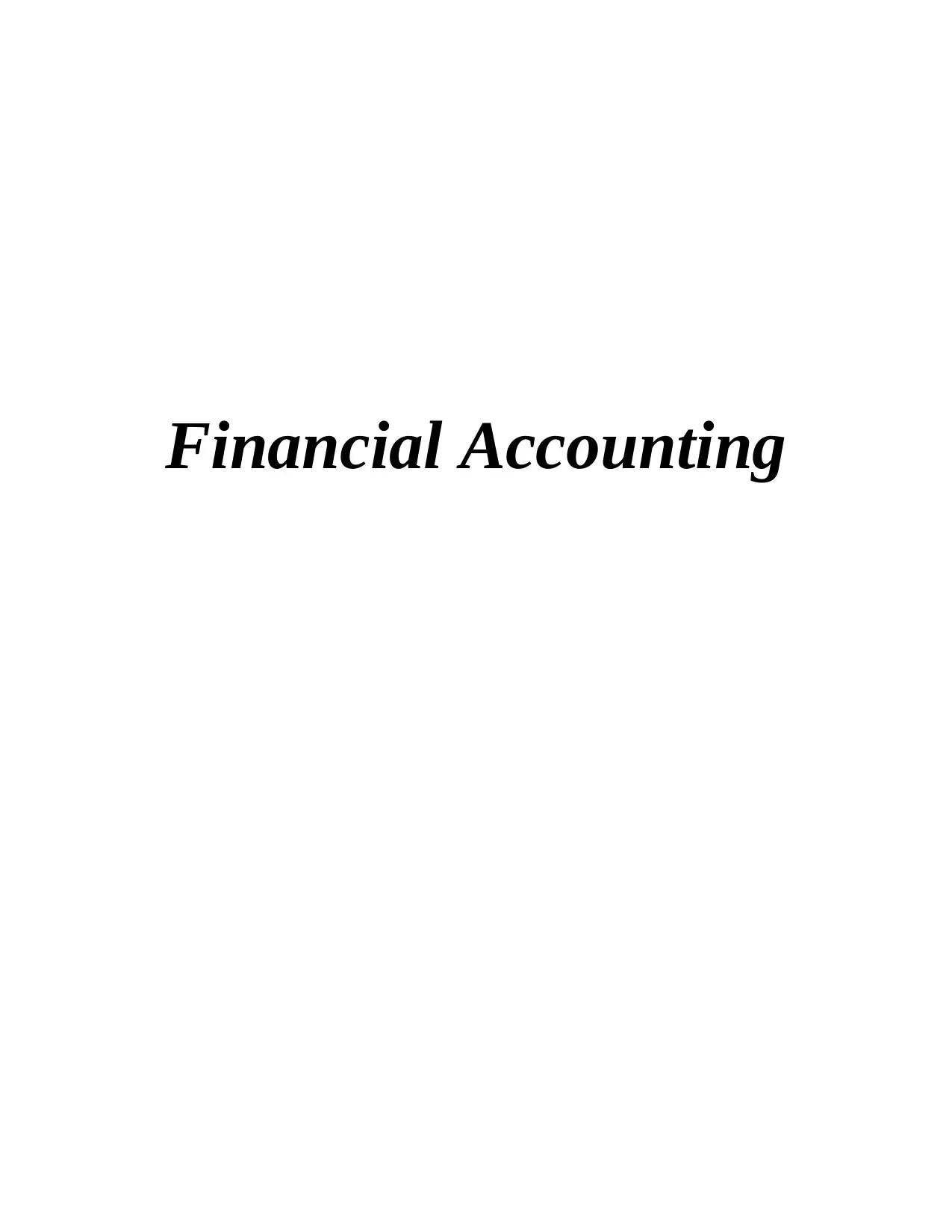
Financial Accounting
Paraphrase This Document
Need a fresh take? Get an instant paraphrase of this document with our AI Paraphraser
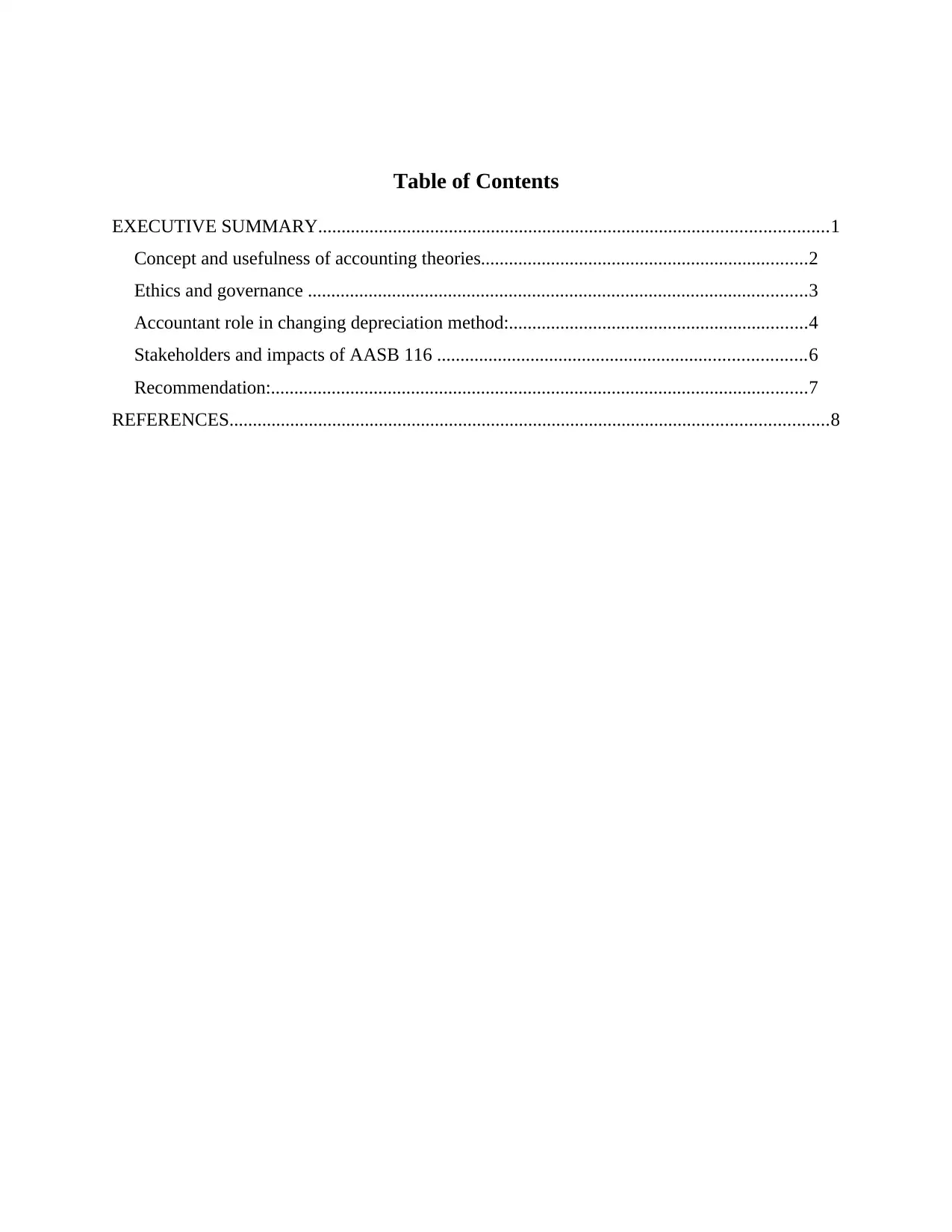
Table of Contents
EXECUTIVE SUMMARY.............................................................................................................1
Concept and usefulness of accounting theories......................................................................2
Ethics and governance ...........................................................................................................3
Accountant role in changing depreciation method:................................................................4
Stakeholders and impacts of AASB 116 ...............................................................................6
Recommendation:...................................................................................................................7
REFERENCES................................................................................................................................8
EXECUTIVE SUMMARY.............................................................................................................1
Concept and usefulness of accounting theories......................................................................2
Ethics and governance ...........................................................................................................3
Accountant role in changing depreciation method:................................................................4
Stakeholders and impacts of AASB 116 ...............................................................................6
Recommendation:...................................................................................................................7
REFERENCES................................................................................................................................8
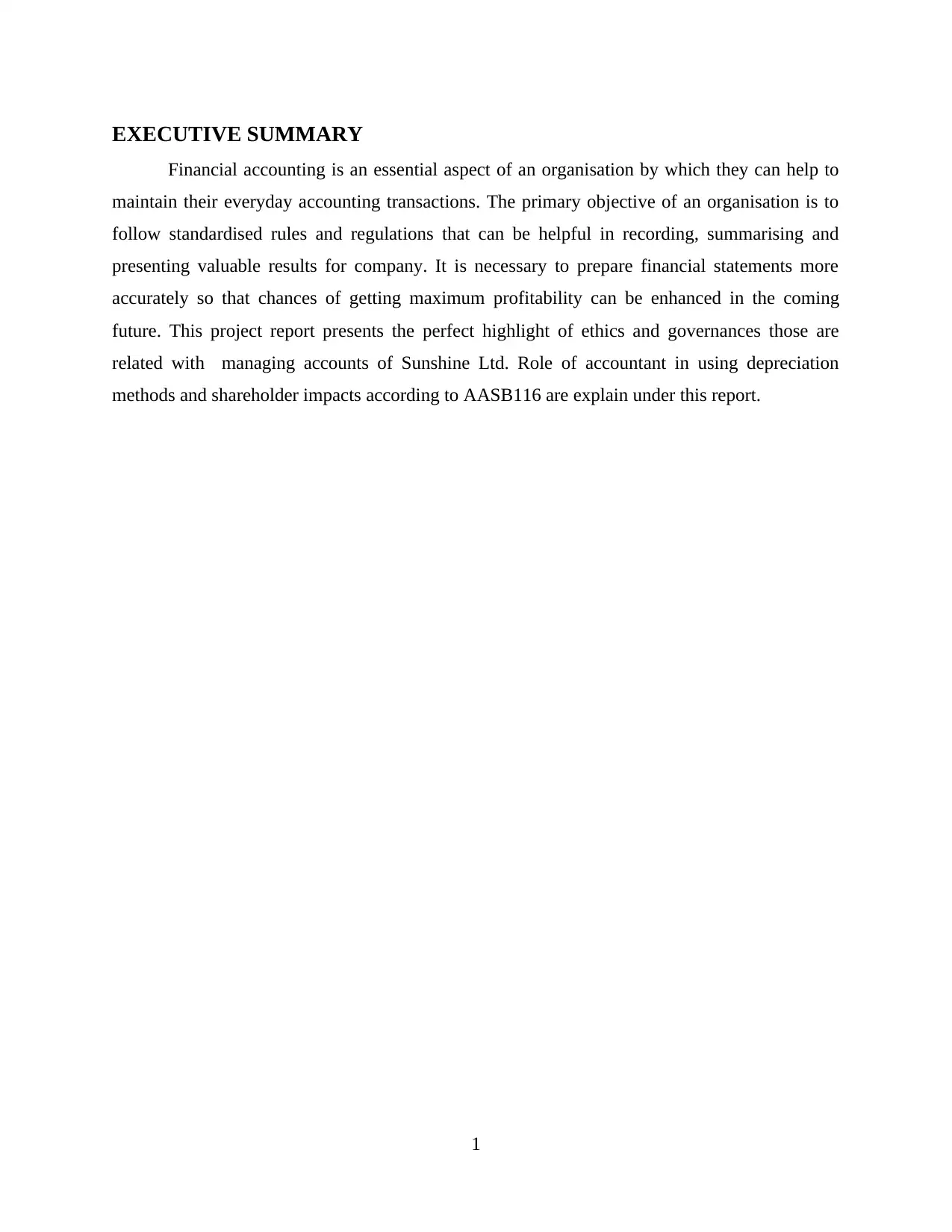
EXECUTIVE SUMMARY
Financial accounting is an essential aspect of an organisation by which they can help to
maintain their everyday accounting transactions. The primary objective of an organisation is to
follow standardised rules and regulations that can be helpful in recording, summarising and
presenting valuable results for company. It is necessary to prepare financial statements more
accurately so that chances of getting maximum profitability can be enhanced in the coming
future. This project report presents the perfect highlight of ethics and governances those are
related with managing accounts of Sunshine Ltd. Role of accountant in using depreciation
methods and shareholder impacts according to AASB116 are explain under this report.
1
Financial accounting is an essential aspect of an organisation by which they can help to
maintain their everyday accounting transactions. The primary objective of an organisation is to
follow standardised rules and regulations that can be helpful in recording, summarising and
presenting valuable results for company. It is necessary to prepare financial statements more
accurately so that chances of getting maximum profitability can be enhanced in the coming
future. This project report presents the perfect highlight of ethics and governances those are
related with managing accounts of Sunshine Ltd. Role of accountant in using depreciation
methods and shareholder impacts according to AASB116 are explain under this report.
1
You're viewing a preview
Unlock full access by subscribing today!
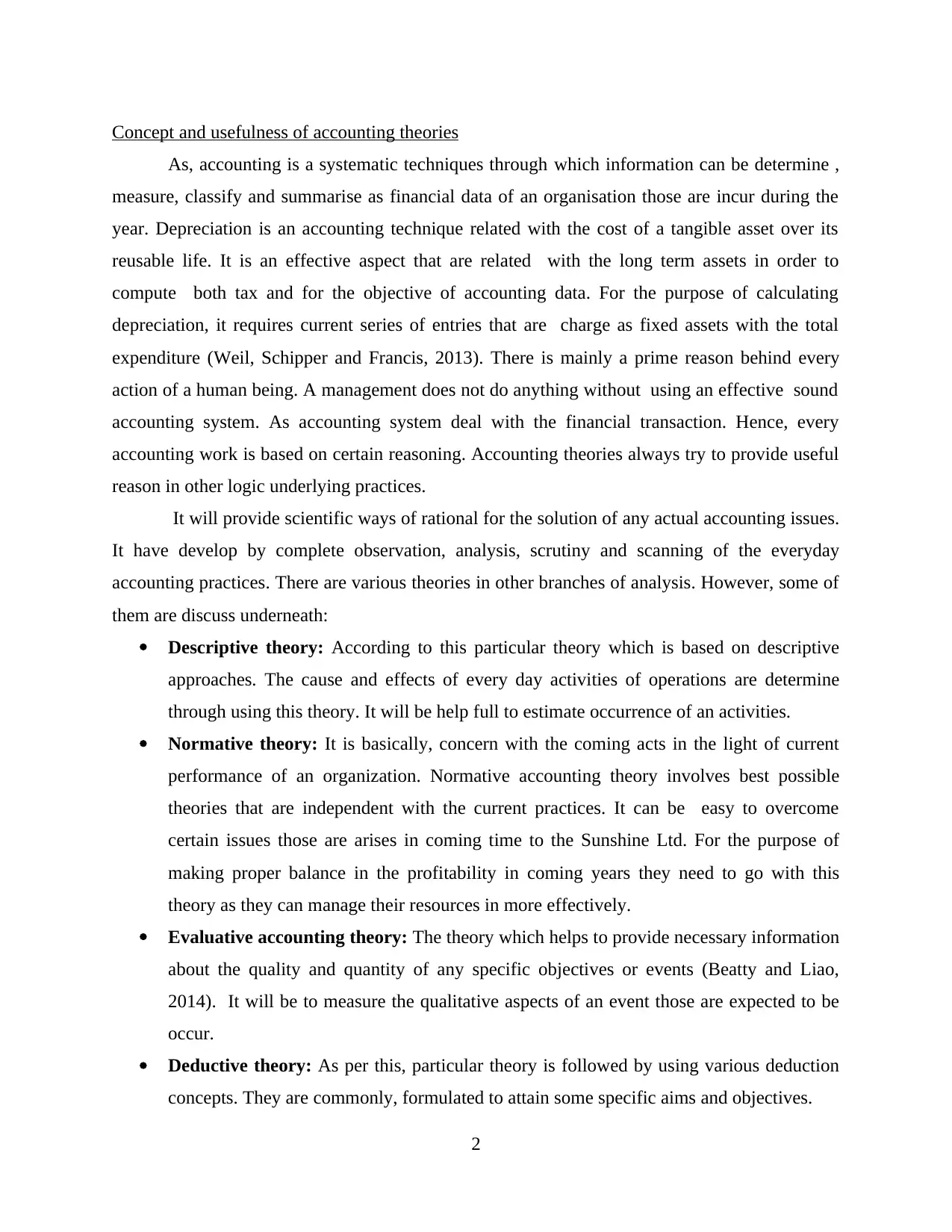
Concept and usefulness of accounting theories
As, accounting is a systematic techniques through which information can be determine ,
measure, classify and summarise as financial data of an organisation those are incur during the
year. Depreciation is an accounting technique related with the cost of a tangible asset over its
reusable life. It is an effective aspect that are related with the long term assets in order to
compute both tax and for the objective of accounting data. For the purpose of calculating
depreciation, it requires current series of entries that are charge as fixed assets with the total
expenditure (Weil, Schipper and Francis, 2013). There is mainly a prime reason behind every
action of a human being. A management does not do anything without using an effective sound
accounting system. As accounting system deal with the financial transaction. Hence, every
accounting work is based on certain reasoning. Accounting theories always try to provide useful
reason in other logic underlying practices.
It will provide scientific ways of rational for the solution of any actual accounting issues.
It have develop by complete observation, analysis, scrutiny and scanning of the everyday
accounting practices. There are various theories in other branches of analysis. However, some of
them are discuss underneath:
Descriptive theory: According to this particular theory which is based on descriptive
approaches. The cause and effects of every day activities of operations are determine
through using this theory. It will be help full to estimate occurrence of an activities.
Normative theory: It is basically, concern with the coming acts in the light of current
performance of an organization. Normative accounting theory involves best possible
theories that are independent with the current practices. It can be easy to overcome
certain issues those are arises in coming time to the Sunshine Ltd. For the purpose of
making proper balance in the profitability in coming years they need to go with this
theory as they can manage their resources in more effectively.
Evaluative accounting theory: The theory which helps to provide necessary information
about the quality and quantity of any specific objectives or events (Beatty and Liao,
2014). It will be to measure the qualitative aspects of an event those are expected to be
occur.
Deductive theory: As per this, particular theory is followed by using various deduction
concepts. They are commonly, formulated to attain some specific aims and objectives.
2
As, accounting is a systematic techniques through which information can be determine ,
measure, classify and summarise as financial data of an organisation those are incur during the
year. Depreciation is an accounting technique related with the cost of a tangible asset over its
reusable life. It is an effective aspect that are related with the long term assets in order to
compute both tax and for the objective of accounting data. For the purpose of calculating
depreciation, it requires current series of entries that are charge as fixed assets with the total
expenditure (Weil, Schipper and Francis, 2013). There is mainly a prime reason behind every
action of a human being. A management does not do anything without using an effective sound
accounting system. As accounting system deal with the financial transaction. Hence, every
accounting work is based on certain reasoning. Accounting theories always try to provide useful
reason in other logic underlying practices.
It will provide scientific ways of rational for the solution of any actual accounting issues.
It have develop by complete observation, analysis, scrutiny and scanning of the everyday
accounting practices. There are various theories in other branches of analysis. However, some of
them are discuss underneath:
Descriptive theory: According to this particular theory which is based on descriptive
approaches. The cause and effects of every day activities of operations are determine
through using this theory. It will be help full to estimate occurrence of an activities.
Normative theory: It is basically, concern with the coming acts in the light of current
performance of an organization. Normative accounting theory involves best possible
theories that are independent with the current practices. It can be easy to overcome
certain issues those are arises in coming time to the Sunshine Ltd. For the purpose of
making proper balance in the profitability in coming years they need to go with this
theory as they can manage their resources in more effectively.
Evaluative accounting theory: The theory which helps to provide necessary information
about the quality and quantity of any specific objectives or events (Beatty and Liao,
2014). It will be to measure the qualitative aspects of an event those are expected to be
occur.
Deductive theory: As per this, particular theory is followed by using various deduction
concepts. They are commonly, formulated to attain some specific aims and objectives.
2
Paraphrase This Document
Need a fresh take? Get an instant paraphrase of this document with our AI Paraphraser
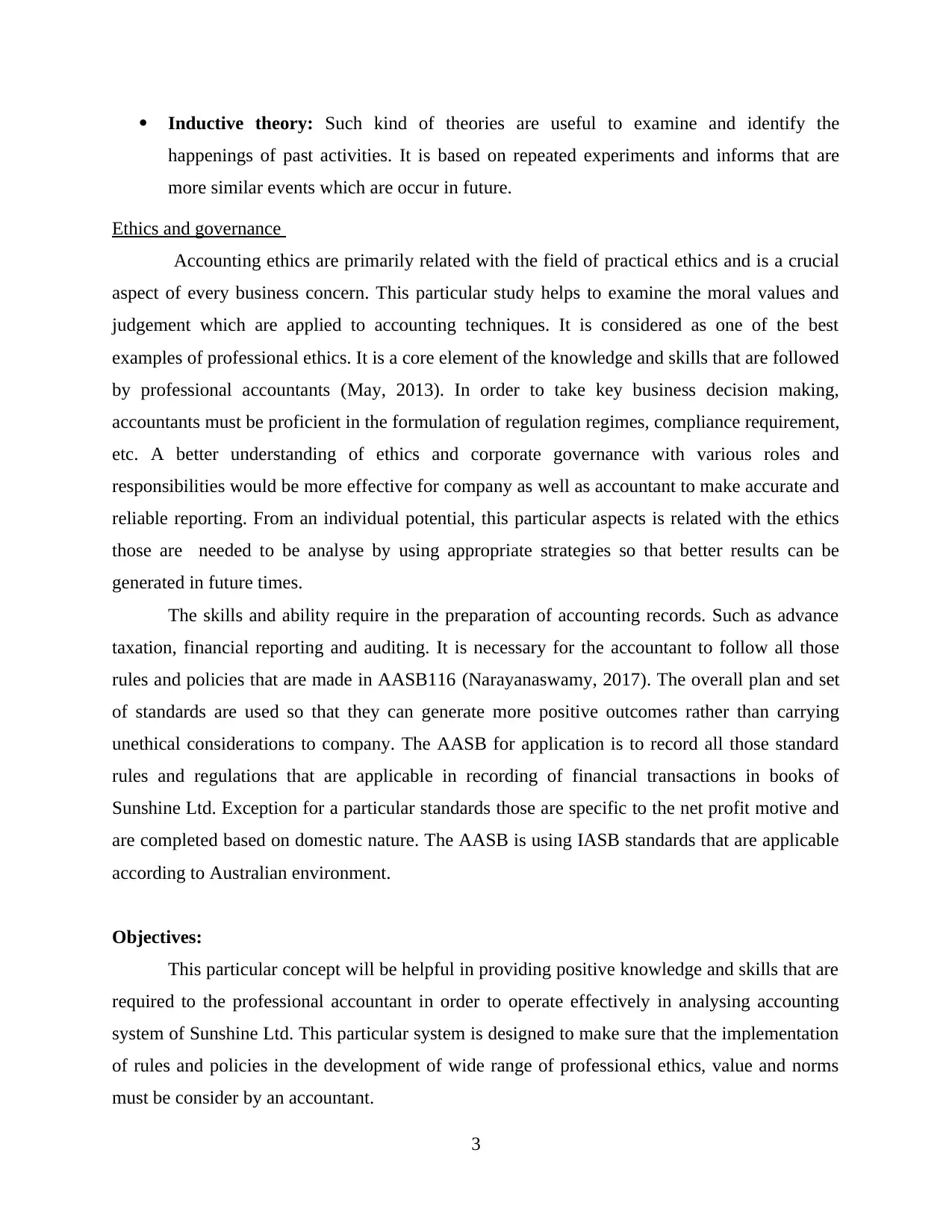
Inductive theory: Such kind of theories are useful to examine and identify the
happenings of past activities. It is based on repeated experiments and informs that are
more similar events which are occur in future.
Ethics and governance
Accounting ethics are primarily related with the field of practical ethics and is a crucial
aspect of every business concern. This particular study helps to examine the moral values and
judgement which are applied to accounting techniques. It is considered as one of the best
examples of professional ethics. It is a core element of the knowledge and skills that are followed
by professional accountants (May, 2013). In order to take key business decision making,
accountants must be proficient in the formulation of regulation regimes, compliance requirement,
etc. A better understanding of ethics and corporate governance with various roles and
responsibilities would be more effective for company as well as accountant to make accurate and
reliable reporting. From an individual potential, this particular aspects is related with the ethics
those are needed to be analyse by using appropriate strategies so that better results can be
generated in future times.
The skills and ability require in the preparation of accounting records. Such as advance
taxation, financial reporting and auditing. It is necessary for the accountant to follow all those
rules and policies that are made in AASB116 (Narayanaswamy, 2017). The overall plan and set
of standards are used so that they can generate more positive outcomes rather than carrying
unethical considerations to company. The AASB for application is to record all those standard
rules and regulations that are applicable in recording of financial transactions in books of
Sunshine Ltd. Exception for a particular standards those are specific to the net profit motive and
are completed based on domestic nature. The AASB is using IASB standards that are applicable
according to Australian environment.
Objectives:
This particular concept will be helpful in providing positive knowledge and skills that are
required to the professional accountant in order to operate effectively in analysing accounting
system of Sunshine Ltd. This particular system is designed to make sure that the implementation
of rules and policies in the development of wide range of professional ethics, value and norms
must be consider by an accountant.
3
happenings of past activities. It is based on repeated experiments and informs that are
more similar events which are occur in future.
Ethics and governance
Accounting ethics are primarily related with the field of practical ethics and is a crucial
aspect of every business concern. This particular study helps to examine the moral values and
judgement which are applied to accounting techniques. It is considered as one of the best
examples of professional ethics. It is a core element of the knowledge and skills that are followed
by professional accountants (May, 2013). In order to take key business decision making,
accountants must be proficient in the formulation of regulation regimes, compliance requirement,
etc. A better understanding of ethics and corporate governance with various roles and
responsibilities would be more effective for company as well as accountant to make accurate and
reliable reporting. From an individual potential, this particular aspects is related with the ethics
those are needed to be analyse by using appropriate strategies so that better results can be
generated in future times.
The skills and ability require in the preparation of accounting records. Such as advance
taxation, financial reporting and auditing. It is necessary for the accountant to follow all those
rules and policies that are made in AASB116 (Narayanaswamy, 2017). The overall plan and set
of standards are used so that they can generate more positive outcomes rather than carrying
unethical considerations to company. The AASB for application is to record all those standard
rules and regulations that are applicable in recording of financial transactions in books of
Sunshine Ltd. Exception for a particular standards those are specific to the net profit motive and
are completed based on domestic nature. The AASB is using IASB standards that are applicable
according to Australian environment.
Objectives:
This particular concept will be helpful in providing positive knowledge and skills that are
required to the professional accountant in order to operate effectively in analysing accounting
system of Sunshine Ltd. This particular system is designed to make sure that the implementation
of rules and policies in the development of wide range of professional ethics, value and norms
must be consider by an accountant.
3
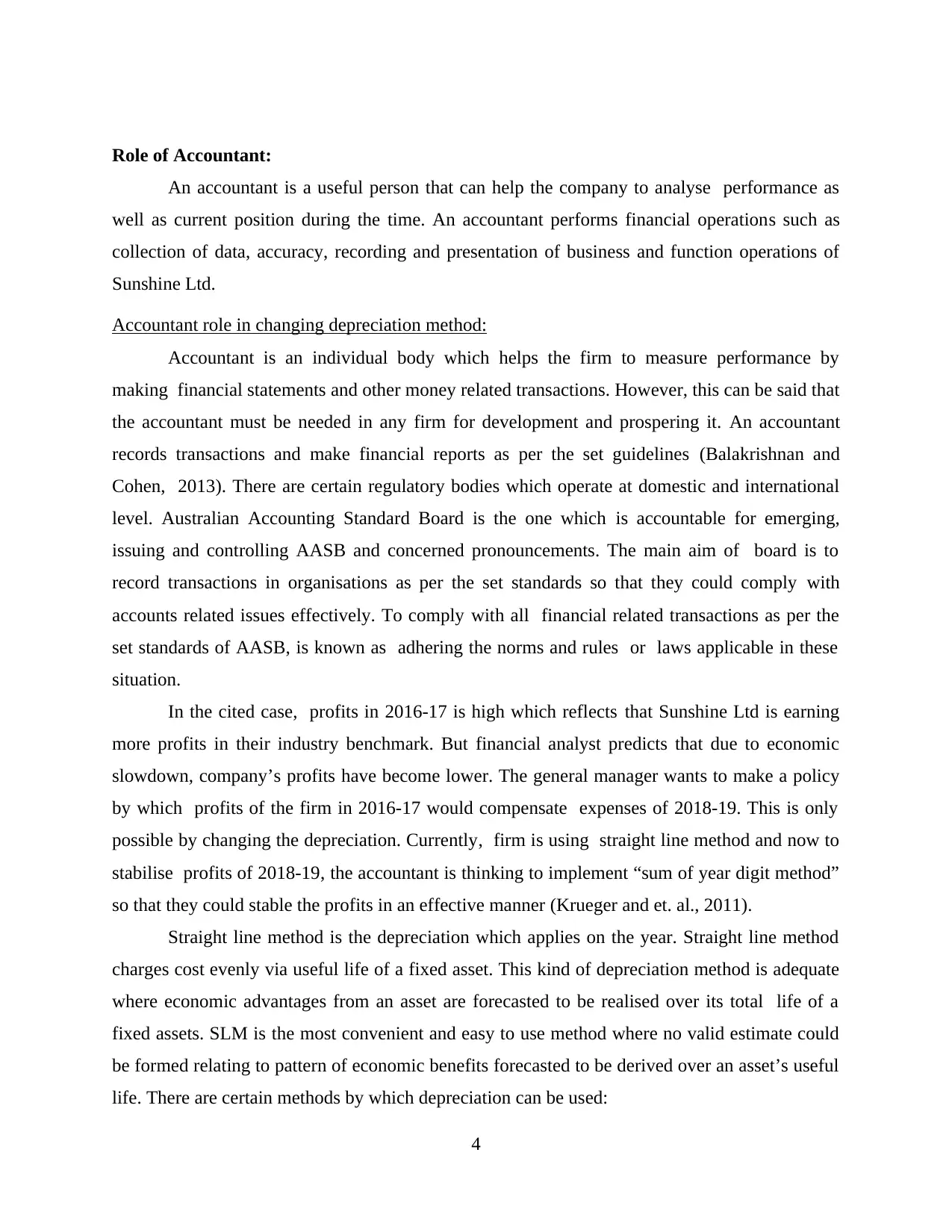
Role of Accountant:
An accountant is a useful person that can help the company to analyse performance as
well as current position during the time. An accountant performs financial operations such as
collection of data, accuracy, recording and presentation of business and function operations of
Sunshine Ltd.
Accountant role in changing depreciation method:
Accountant is an individual body which helps the firm to measure performance by
making financial statements and other money related transactions. However, this can be said that
the accountant must be needed in any firm for development and prospering it. An accountant
records transactions and make financial reports as per the set guidelines (Balakrishnan and
Cohen, 2013). There are certain regulatory bodies which operate at domestic and international
level. Australian Accounting Standard Board is the one which is accountable for emerging,
issuing and controlling AASB and concerned pronouncements. The main aim of board is to
record transactions in organisations as per the set standards so that they could comply with
accounts related issues effectively. To comply with all financial related transactions as per the
set standards of AASB, is known as adhering the norms and rules or laws applicable in these
situation.
In the cited case, profits in 2016-17 is high which reflects that Sunshine Ltd is earning
more profits in their industry benchmark. But financial analyst predicts that due to economic
slowdown, company’s profits have become lower. The general manager wants to make a policy
by which profits of the firm in 2016-17 would compensate expenses of 2018-19. This is only
possible by changing the depreciation. Currently, firm is using straight line method and now to
stabilise profits of 2018-19, the accountant is thinking to implement “sum of year digit method”
so that they could stable the profits in an effective manner (Krueger and et. al., 2011).
Straight line method is the depreciation which applies on the year. Straight line method
charges cost evenly via useful life of a fixed asset. This kind of depreciation method is adequate
where economic advantages from an asset are forecasted to be realised over its total life of a
fixed assets. SLM is the most convenient and easy to use method where no valid estimate could
be formed relating to pattern of economic benefits forecasted to be derived over an asset’s useful
life. There are certain methods by which depreciation can be used:
4
An accountant is a useful person that can help the company to analyse performance as
well as current position during the time. An accountant performs financial operations such as
collection of data, accuracy, recording and presentation of business and function operations of
Sunshine Ltd.
Accountant role in changing depreciation method:
Accountant is an individual body which helps the firm to measure performance by
making financial statements and other money related transactions. However, this can be said that
the accountant must be needed in any firm for development and prospering it. An accountant
records transactions and make financial reports as per the set guidelines (Balakrishnan and
Cohen, 2013). There are certain regulatory bodies which operate at domestic and international
level. Australian Accounting Standard Board is the one which is accountable for emerging,
issuing and controlling AASB and concerned pronouncements. The main aim of board is to
record transactions in organisations as per the set standards so that they could comply with
accounts related issues effectively. To comply with all financial related transactions as per the
set standards of AASB, is known as adhering the norms and rules or laws applicable in these
situation.
In the cited case, profits in 2016-17 is high which reflects that Sunshine Ltd is earning
more profits in their industry benchmark. But financial analyst predicts that due to economic
slowdown, company’s profits have become lower. The general manager wants to make a policy
by which profits of the firm in 2016-17 would compensate expenses of 2018-19. This is only
possible by changing the depreciation. Currently, firm is using straight line method and now to
stabilise profits of 2018-19, the accountant is thinking to implement “sum of year digit method”
so that they could stable the profits in an effective manner (Krueger and et. al., 2011).
Straight line method is the depreciation which applies on the year. Straight line method
charges cost evenly via useful life of a fixed asset. This kind of depreciation method is adequate
where economic advantages from an asset are forecasted to be realised over its total life of a
fixed assets. SLM is the most convenient and easy to use method where no valid estimate could
be formed relating to pattern of economic benefits forecasted to be derived over an asset’s useful
life. There are certain methods by which depreciation can be used:
4
You're viewing a preview
Unlock full access by subscribing today!
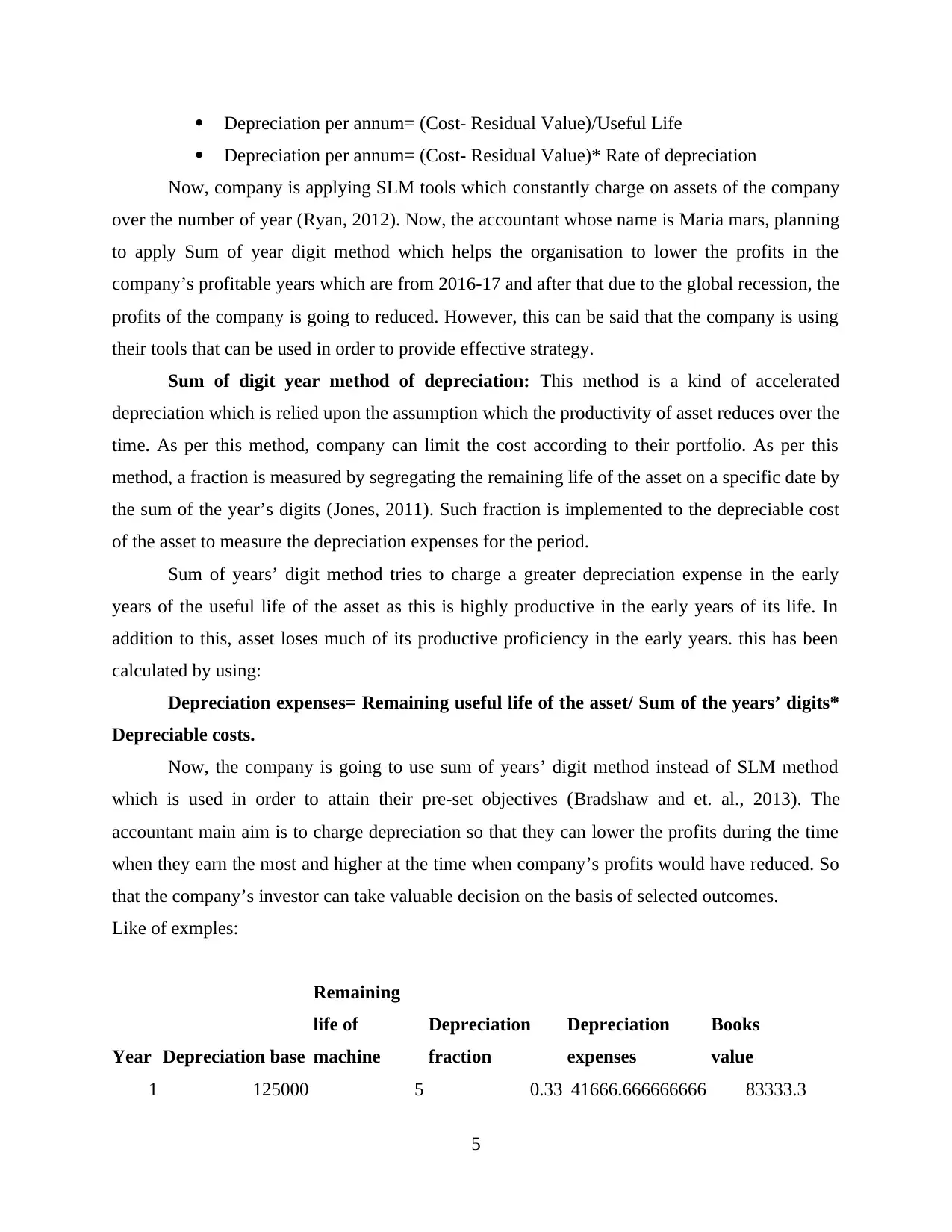
Depreciation per annum= (Cost- Residual Value)/Useful Life
Depreciation per annum= (Cost- Residual Value)* Rate of depreciation
Now, company is applying SLM tools which constantly charge on assets of the company
over the number of year (Ryan, 2012). Now, the accountant whose name is Maria mars, planning
to apply Sum of year digit method which helps the organisation to lower the profits in the
company’s profitable years which are from 2016-17 and after that due to the global recession, the
profits of the company is going to reduced. However, this can be said that the company is using
their tools that can be used in order to provide effective strategy.
Sum of digit year method of depreciation: This method is a kind of accelerated
depreciation which is relied upon the assumption which the productivity of asset reduces over the
time. As per this method, company can limit the cost according to their portfolio. As per this
method, a fraction is measured by segregating the remaining life of the asset on a specific date by
the sum of the year’s digits (Jones, 2011). Such fraction is implemented to the depreciable cost
of the asset to measure the depreciation expenses for the period.
Sum of years’ digit method tries to charge a greater depreciation expense in the early
years of the useful life of the asset as this is highly productive in the early years of its life. In
addition to this, asset loses much of its productive proficiency in the early years. this has been
calculated by using:
Depreciation expenses= Remaining useful life of the asset/ Sum of the years’ digits*
Depreciable costs.
Now, the company is going to use sum of years’ digit method instead of SLM method
which is used in order to attain their pre-set objectives (Bradshaw and et. al., 2013). The
accountant main aim is to charge depreciation so that they can lower the profits during the time
when they earn the most and higher at the time when company’s profits would have reduced. So
that the company’s investor can take valuable decision on the basis of selected outcomes.
Like of exmples:
Year Depreciation base
Remaining
life of
machine
Depreciation
fraction
Depreciation
expenses
Books
value
1 125000 5 0.33 41666.666666666 83333.3
5
Depreciation per annum= (Cost- Residual Value)* Rate of depreciation
Now, company is applying SLM tools which constantly charge on assets of the company
over the number of year (Ryan, 2012). Now, the accountant whose name is Maria mars, planning
to apply Sum of year digit method which helps the organisation to lower the profits in the
company’s profitable years which are from 2016-17 and after that due to the global recession, the
profits of the company is going to reduced. However, this can be said that the company is using
their tools that can be used in order to provide effective strategy.
Sum of digit year method of depreciation: This method is a kind of accelerated
depreciation which is relied upon the assumption which the productivity of asset reduces over the
time. As per this method, company can limit the cost according to their portfolio. As per this
method, a fraction is measured by segregating the remaining life of the asset on a specific date by
the sum of the year’s digits (Jones, 2011). Such fraction is implemented to the depreciable cost
of the asset to measure the depreciation expenses for the period.
Sum of years’ digit method tries to charge a greater depreciation expense in the early
years of the useful life of the asset as this is highly productive in the early years of its life. In
addition to this, asset loses much of its productive proficiency in the early years. this has been
calculated by using:
Depreciation expenses= Remaining useful life of the asset/ Sum of the years’ digits*
Depreciable costs.
Now, the company is going to use sum of years’ digit method instead of SLM method
which is used in order to attain their pre-set objectives (Bradshaw and et. al., 2013). The
accountant main aim is to charge depreciation so that they can lower the profits during the time
when they earn the most and higher at the time when company’s profits would have reduced. So
that the company’s investor can take valuable decision on the basis of selected outcomes.
Like of exmples:
Year Depreciation base
Remaining
life of
machine
Depreciation
fraction
Depreciation
expenses
Books
value
1 125000 5 0.33 41666.666666666 83333.3
5
Paraphrase This Document
Need a fresh take? Get an instant paraphrase of this document with our AI Paraphraser
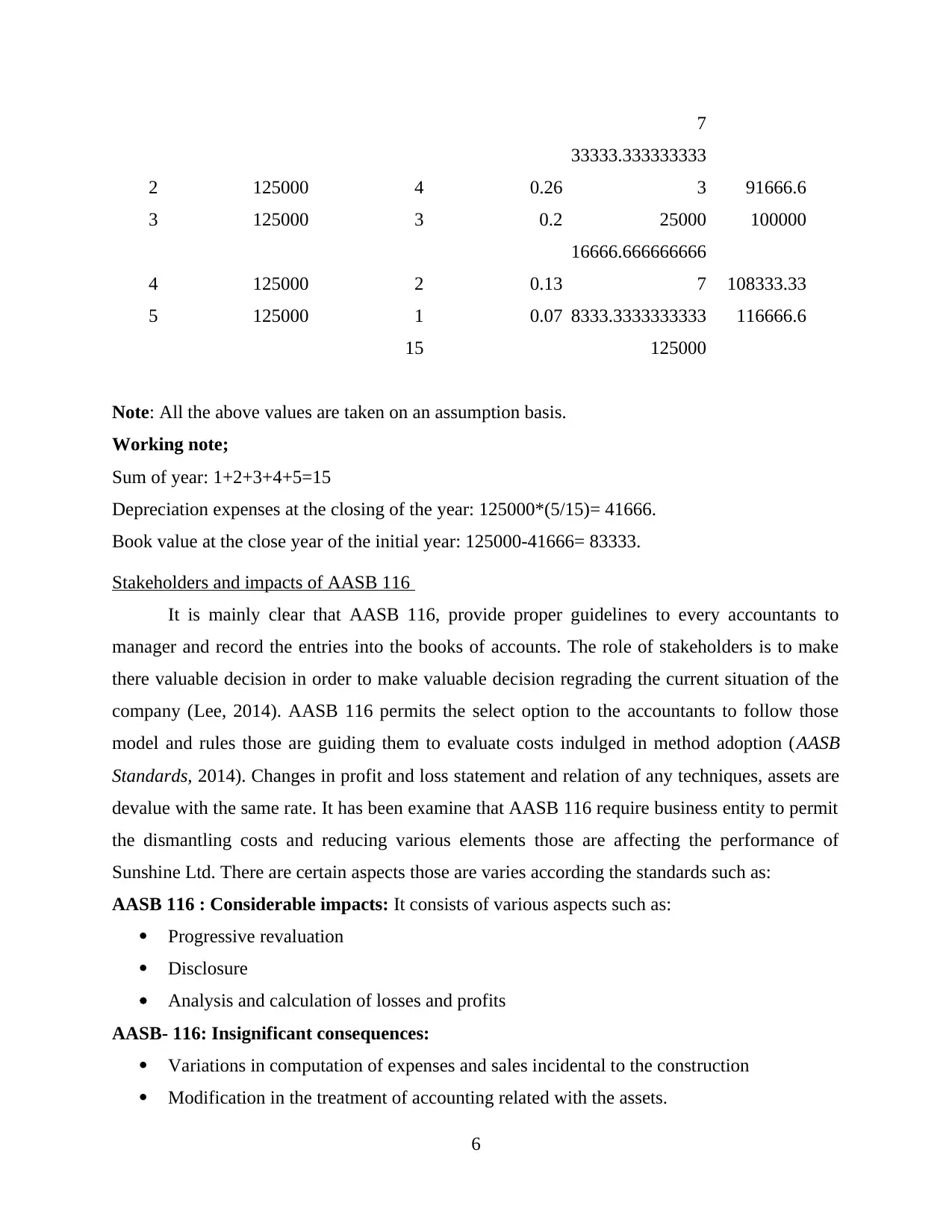
7
2 125000 4 0.26
33333.333333333
3 91666.6
3 125000 3 0.2 25000 100000
4 125000 2 0.13
16666.666666666
7 108333.33
5 125000 1 0.07 8333.3333333333 116666.6
15 125000
Note: All the above values are taken on an assumption basis.
Working note;
Sum of year: 1+2+3+4+5=15
Depreciation expenses at the closing of the year: 125000*(5/15)= 41666.
Book value at the close year of the initial year: 125000-41666= 83333.
Stakeholders and impacts of AASB 116
It is mainly clear that AASB 116, provide proper guidelines to every accountants to
manager and record the entries into the books of accounts. The role of stakeholders is to make
there valuable decision in order to make valuable decision regrading the current situation of the
company (Lee, 2014). AASB 116 permits the select option to the accountants to follow those
model and rules those are guiding them to evaluate costs indulged in method adoption (AASB
Standards, 2014). Changes in profit and loss statement and relation of any techniques, assets are
devalue with the same rate. It has been examine that AASB 116 require business entity to permit
the dismantling costs and reducing various elements those are affecting the performance of
Sunshine Ltd. There are certain aspects those are varies according the standards such as:
AASB 116 : Considerable impacts: It consists of various aspects such as:
Progressive revaluation
Disclosure
Analysis and calculation of losses and profits
AASB- 116: Insignificant consequences:
Variations in computation of expenses and sales incidental to the construction
Modification in the treatment of accounting related with the assets.
6
2 125000 4 0.26
33333.333333333
3 91666.6
3 125000 3 0.2 25000 100000
4 125000 2 0.13
16666.666666666
7 108333.33
5 125000 1 0.07 8333.3333333333 116666.6
15 125000
Note: All the above values are taken on an assumption basis.
Working note;
Sum of year: 1+2+3+4+5=15
Depreciation expenses at the closing of the year: 125000*(5/15)= 41666.
Book value at the close year of the initial year: 125000-41666= 83333.
Stakeholders and impacts of AASB 116
It is mainly clear that AASB 116, provide proper guidelines to every accountants to
manager and record the entries into the books of accounts. The role of stakeholders is to make
there valuable decision in order to make valuable decision regrading the current situation of the
company (Lee, 2014). AASB 116 permits the select option to the accountants to follow those
model and rules those are guiding them to evaluate costs indulged in method adoption (AASB
Standards, 2014). Changes in profit and loss statement and relation of any techniques, assets are
devalue with the same rate. It has been examine that AASB 116 require business entity to permit
the dismantling costs and reducing various elements those are affecting the performance of
Sunshine Ltd. There are certain aspects those are varies according the standards such as:
AASB 116 : Considerable impacts: It consists of various aspects such as:
Progressive revaluation
Disclosure
Analysis and calculation of losses and profits
AASB- 116: Insignificant consequences:
Variations in computation of expenses and sales incidental to the construction
Modification in the treatment of accounting related with the assets.
6
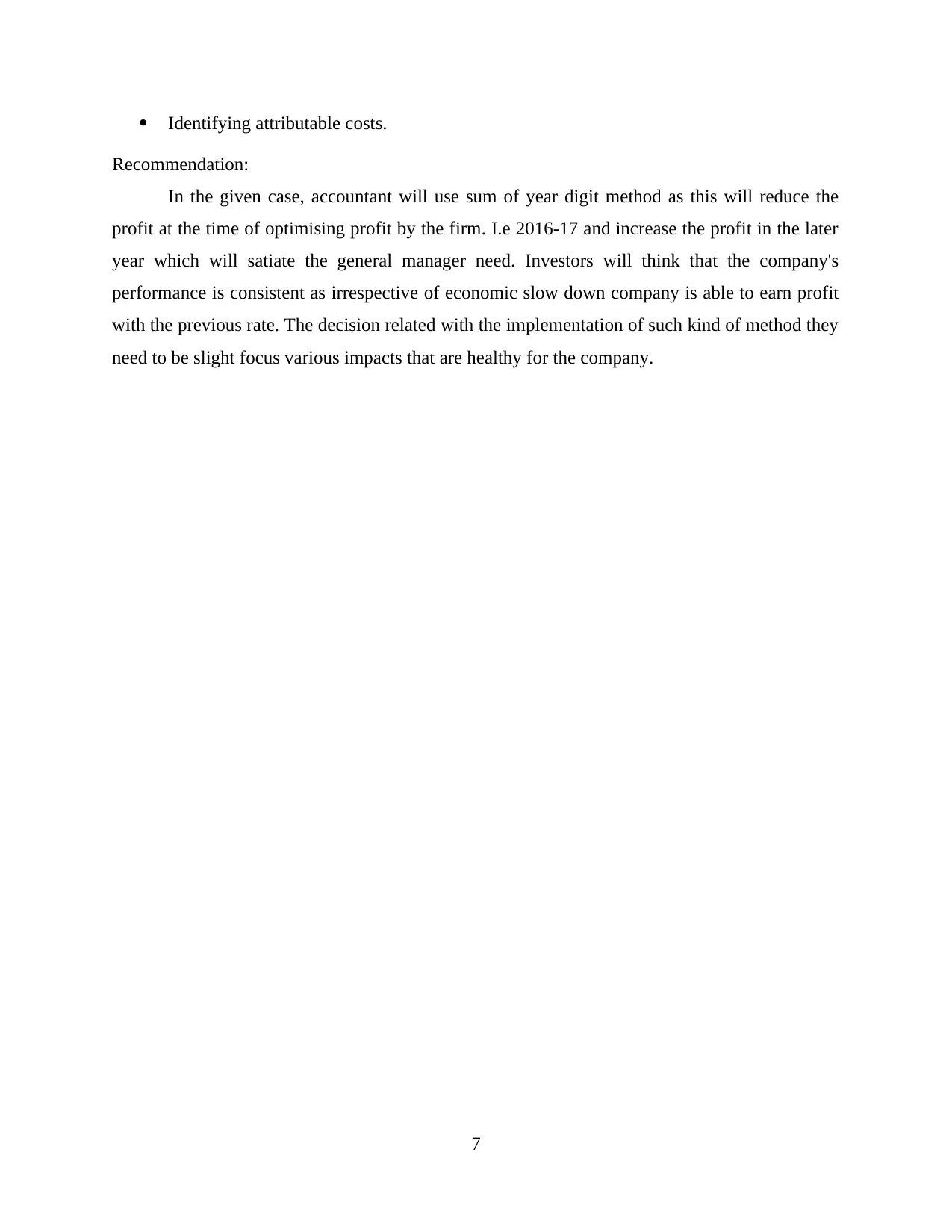
Identifying attributable costs.
Recommendation:
In the given case, accountant will use sum of year digit method as this will reduce the
profit at the time of optimising profit by the firm. I.e 2016-17 and increase the profit in the later
year which will satiate the general manager need. Investors will think that the company's
performance is consistent as irrespective of economic slow down company is able to earn profit
with the previous rate. The decision related with the implementation of such kind of method they
need to be slight focus various impacts that are healthy for the company.
7
Recommendation:
In the given case, accountant will use sum of year digit method as this will reduce the
profit at the time of optimising profit by the firm. I.e 2016-17 and increase the profit in the later
year which will satiate the general manager need. Investors will think that the company's
performance is consistent as irrespective of economic slow down company is able to earn profit
with the previous rate. The decision related with the implementation of such kind of method they
need to be slight focus various impacts that are healthy for the company.
7
You're viewing a preview
Unlock full access by subscribing today!
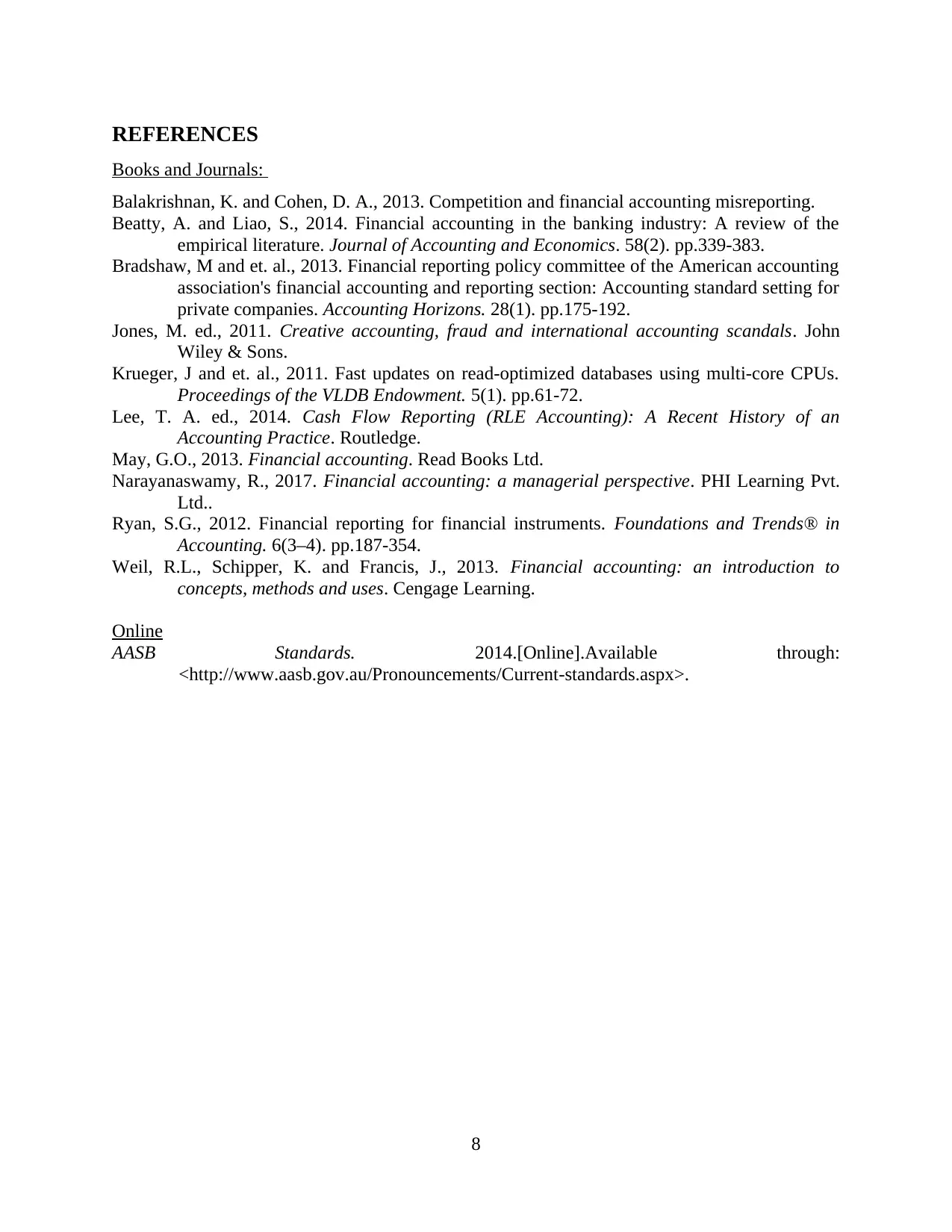
REFERENCES
Books and Journals:
Balakrishnan, K. and Cohen, D. A., 2013. Competition and financial accounting misreporting.
Beatty, A. and Liao, S., 2014. Financial accounting in the banking industry: A review of the
empirical literature. Journal of Accounting and Economics. 58(2). pp.339-383.
Bradshaw, M and et. al., 2013. Financial reporting policy committee of the American accounting
association's financial accounting and reporting section: Accounting standard setting for
private companies. Accounting Horizons. 28(1). pp.175-192.
Jones, M. ed., 2011. Creative accounting, fraud and international accounting scandals. John
Wiley & Sons.
Krueger, J and et. al., 2011. Fast updates on read-optimized databases using multi-core CPUs.
Proceedings of the VLDB Endowment. 5(1). pp.61-72.
Lee, T. A. ed., 2014. Cash Flow Reporting (RLE Accounting): A Recent History of an
Accounting Practice. Routledge.
May, G.O., 2013. Financial accounting. Read Books Ltd.
Narayanaswamy, R., 2017. Financial accounting: a managerial perspective. PHI Learning Pvt.
Ltd..
Ryan, S.G., 2012. Financial reporting for financial instruments. Foundations and Trends® in
Accounting. 6(3–4). pp.187-354.
Weil, R.L., Schipper, K. and Francis, J., 2013. Financial accounting: an introduction to
concepts, methods and uses. Cengage Learning.
Online
AASB Standards. 2014.[Online].Available through:
<http://www.aasb.gov.au/Pronouncements/Current-standards.aspx>.
8
Books and Journals:
Balakrishnan, K. and Cohen, D. A., 2013. Competition and financial accounting misreporting.
Beatty, A. and Liao, S., 2014. Financial accounting in the banking industry: A review of the
empirical literature. Journal of Accounting and Economics. 58(2). pp.339-383.
Bradshaw, M and et. al., 2013. Financial reporting policy committee of the American accounting
association's financial accounting and reporting section: Accounting standard setting for
private companies. Accounting Horizons. 28(1). pp.175-192.
Jones, M. ed., 2011. Creative accounting, fraud and international accounting scandals. John
Wiley & Sons.
Krueger, J and et. al., 2011. Fast updates on read-optimized databases using multi-core CPUs.
Proceedings of the VLDB Endowment. 5(1). pp.61-72.
Lee, T. A. ed., 2014. Cash Flow Reporting (RLE Accounting): A Recent History of an
Accounting Practice. Routledge.
May, G.O., 2013. Financial accounting. Read Books Ltd.
Narayanaswamy, R., 2017. Financial accounting: a managerial perspective. PHI Learning Pvt.
Ltd..
Ryan, S.G., 2012. Financial reporting for financial instruments. Foundations and Trends® in
Accounting. 6(3–4). pp.187-354.
Weil, R.L., Schipper, K. and Francis, J., 2013. Financial accounting: an introduction to
concepts, methods and uses. Cengage Learning.
Online
AASB Standards. 2014.[Online].Available through:
<http://www.aasb.gov.au/Pronouncements/Current-standards.aspx>.
8
1 out of 10
Related Documents
Your All-in-One AI-Powered Toolkit for Academic Success.
+13062052269
info@desklib.com
Available 24*7 on WhatsApp / Email
![[object Object]](/_next/static/media/star-bottom.7253800d.svg)
Unlock your academic potential
© 2024 | Zucol Services PVT LTD | All rights reserved.





